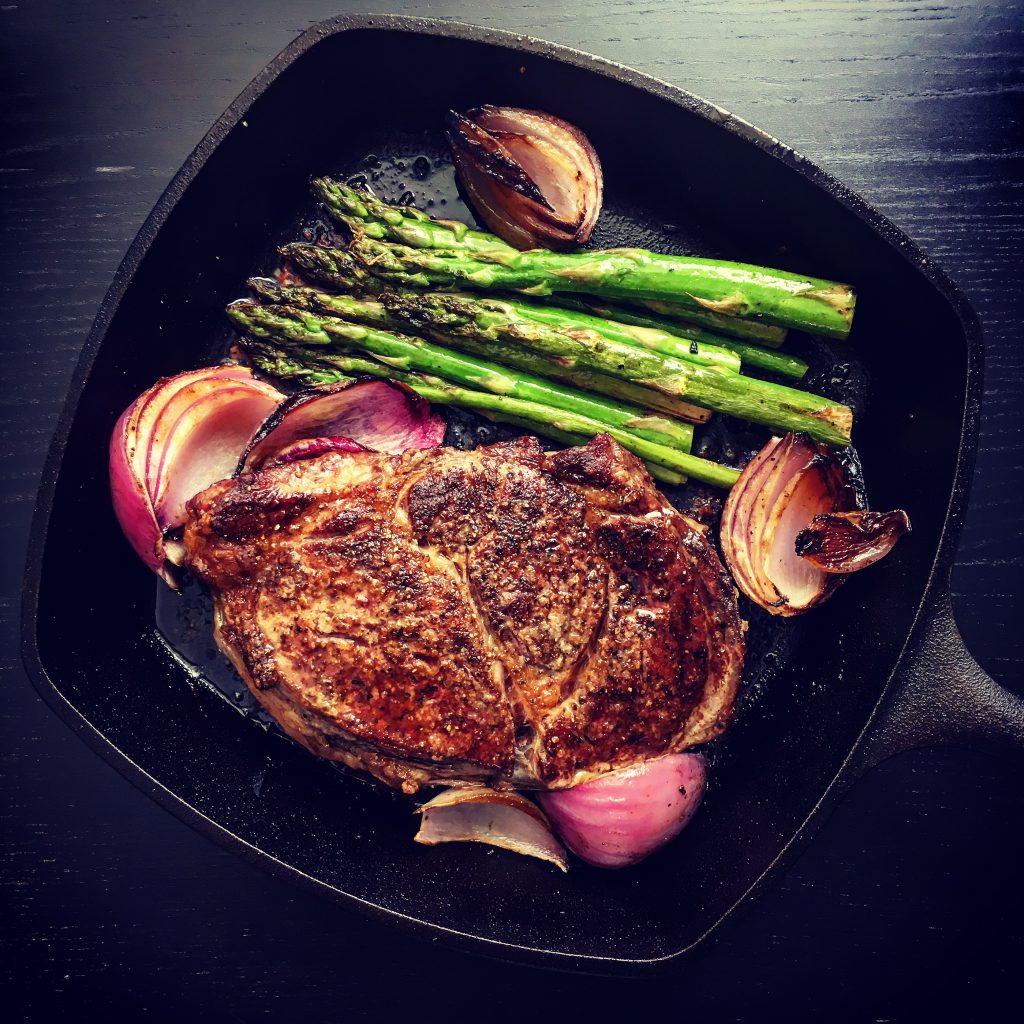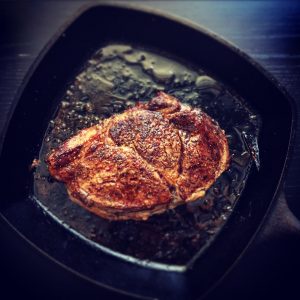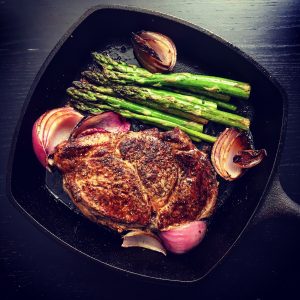How to Cook Steak: Best Recipe Ever

Unless you’re a vegetarian, you know that — when it’s prepared right — steak can be great.
There is a very good reason beef is so popular in America, but also in other countries like Argentina, France, Italy, or Australia. That many people can’t be wrong!
Restaurant studies have shown that diners want steak that is moist and tender. Let me show you how to create the perfect steak, I guarantee it will be deliciously moist and tender so that you can impress your family and friends.
On top of that, a great steak, even a rib-eye beautifully marbled with fat, is something you must not fear if you’re trying to lose weight. Choose side dishes carefully and embrace the delicious, moist, and tender steak recipe I’ve shared in this video.
USDA Prime or Choice?
First, if you can afford it, choose USDA Prime over Choice. The quality makes a difference. Angus beef is a fantastic breed, and so is Hereford.
Corn or grass-fed?
Next, you must decide if you’re going to go with corn-fed or grass-fed beef. That’s a question of taste. Corn-fed beef is very tender and tasty — mainly because the marbling is more apparent. Marbling is important, and it’s one of the qualities you must look at when choosing a steak.
Grass-fed is more of an acquired taste, much leaner, and for that reason, more difficult to cook correctly.
Dry-aging
Dry-aging, if you have the option, is a big plus. Dry-aging just means that each steak has been left to dry out for a few days, resulting in slight dehydration, and therefore in concentration of taste, and depth of flavor. The meat loses weight in the process, and that’s why dry-aged beef is more expensive. Worth it, though, if you can afford it.
You can dry-age your steaks at home. All you have to do is pat the meat dry with paper towels. Wrap your steaks (they should not touch each other) in cheesecloth, and put them on a rack doubled with a sheet pan, so that air can circulate all around the steaks.
You can actually refrigerate for several days and unwrap and rewrap every other day.
If you do choose to dry age your own steak, you may have to shave off and discard some hard, dried outer layers when the process is complete.
Achieving a great golden-brown crust
This is the most satisfying part of eating a steak: the crust. To build a great crust, you need to:
- Make sure the steaks are dry and free of water (pat dry with paper towels if necessary).
- Brush the steaks with a bit of extra-virgin olive oil.
- Use a cast-iron skillet, or a performing grill.
- Monitor the heat to avoid burning or a weak sear.
I usually sear in a cast-iron skillet or a grill to build that lovely crust, then if necessary, I finish cooking the steaks in the oven ( at 350 degrees F) or on the top rack of the grill, covered, at lowered heat.
Understanding and controlling heat
Cooking a steak is simple; cooking it to perfection requires you to understand and control the heat. Whatever technique you use: grilling, searing, finishing in the oven, charcoal grilling, or even broiling (not recommended)… it’s important that you pay some attention to the way it cooks. I recommend you choose one technique and perfect it over time before switching to another.
As a general rule, I have seen the best results when I apply really high heat first (searing) and then lower the heat significantly.
Choosing a thicker cut of steak is important. Here is exactly why:
- Thicker cuts provide a much better mouthfeel and texture. So it’s important for that reason alone.
- A thick-cut steak allows for much better control of the heat. When you think about it, heat travels more slowly through a thick cut steak, and therefore the window between undercooking and overcooking is much wider, and more permissive of errors.
I recommend using a thermometer to monitor the heat. That’s the surest way to get your steak at the right temperature for your tastes.
Other old wives’ tales, such as pressing parts of your hand to tell if the steak is done, are no good. Instead use this guide (where I share my thoughts on well-done steak.)
BEST STEAK EVER
| Active time: 10 minutes | Cook time: 6 to 15 minutes, depending on desired temperature| Yield: 2 servings |
Ingredients:
- 2 14-oz beef ribeye steaks, preferably Prime and dry aged
- Freshly ground black pepper to taste
- Kosher salt to taste (or sea salt such as “fleur de sel”)
- 1 tablespoon extra-virgin olive oil
Preparation:
- Pat the steaks dry with a paper towel to remove any excess moisture, then season generously with salt and pepper (undersalting is a common beginner mistake).
- Rub the steaks with just enough olive oil to coat.
- Heat up a large cast iron skillet under medium-high heat. Once the pan is hot, Place the steaks in the middle of the pan, making sure the thermic shock creates the characteristic searing noise: ‘Pssshhhh”.
- Control the heat and refrain from moving the steak. The goal is to create a nice golden brown crust. Do not cover. After about 3 minutes, flip the steaks over and sear for another 3 minutes to create browning on the other side.
- Using a meat thermometer, check the steaks for doneness. You must insert the thermometer and take a reading in the very center of the steak.
- The steaks may need to finish cooking in a 375F oven if the desired temperature is not reached.
| Steak doneness | Remove from grill at this temperature | Final cooked temperature |
| Rare | 125 F | 130 F |
| Medium rare | 135 F | 140 F |
| Medium | 145 F | 150 F |
| Well done | I’m not talking to you | Go away |
Transfer steak to a cutting board, cover with aluminum foil, and allow to rest for half its cooking time. Slice and serve immediately after resting time.
On the other hand, here is the most important tip if you’re interested in creating the perfect steak. After you cook the steak, let it rest for about half the cooking time. That will allows it to rehydrate with its juices and will produce a moist and an incredibly tender steak.
Finally, while the best cuts are probably ribeye (tastiest) or tenderloin (most tender), you can use the same technique for other, cheaper cuts.
 If you are on a budget, go for skirt, flank, or flat iron steak. If you want to splurge to impress your friends and family, indulge in filet mignon or ETR Editor Craig Ballantyne’s favorite, the rib-eye steak.
If you are on a budget, go for skirt, flank, or flat iron steak. If you want to splurge to impress your friends and family, indulge in filet mignon or ETR Editor Craig Ballantyne’s favorite, the rib-eye steak.
As you can tell, I have a passion for great meat and cooking it right. I can’t wait to see what you’re up to. Email me and send me photos. I would love to see how successful you are at cooking your own and how you impress your family and friends with the best steak ever.
And if you want another delicious recipe, try fajitas.
To your great grilling success,
![]()

